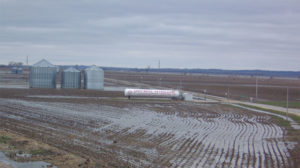Midwest grapples with propane supply, distribution issues
Propane demand in the Midwest has soared, as farmers face an extremely wet harvest combined with an early blast of winter-like weather. And it’s only November.

Sapp Brothers, based in Omaha, Nebraska, and its farming customers were not spared from the severe flooding that hit the Midwest region earlier this year. Photo by Pat Athen/Sapp Brothers
“We’re having transportation and pipeline logistics issues,” says Lesley Garland, vice president of state affairs at the National Propane Gas Association (NPGA). “The volumes they’re needing in the Midwest right now are incredible. Everything between crop drying, livestock heating, other ag heating, residential heating; they need a lot of propane right now.”
The Federal Motor Carrier Safety Administration (FMCSA) issued a regional emergency declaration Nov. 1 for the Midwestern Service Center and Western Service Center, including for Illinois, Iowa, Kansas, Minnesota, Missouri, Nebraska, South Dakota and Wisconsin. The FMCSA extended and amended the emergency declaration to include the Southern Service Center and the additional states of Indiana, Kentucky and North Dakota.
The FMCSA cites an early onset of winter weather conditions, flooding and high demand as key factors in issuing the emergency. According to NPGA in late October, corn was harvesting at a slow, constant pace, presenting consistent propane demand for crop dryers.
The declaration provides for regulatory relief for commercial motor vehicle operations while providing direct assistance to support emergency relief efforts transporting heating fuel, including propane, into the affected states. It is in effect for the duration of the emergency or until 11:59 p.m. Jan 10, 2020, whichever is less, the FMCSA states. The declaration was originally set to expire Nov. 30 before an extension was issued.
“We put out notices about getting tanks filled early. The Farm Bureau and the Department of Agriculture put out notices to get prepared because they anticipated a late harvest,” says Deb Grooms, CEO of the Iowa Propane Gas Association. “What we were not anticipating was how much propane it would take to dry that wet corn.”
Remembering the 2013-14 winter
The propane industry last experienced severe regional supply and distribution challenges and price spikes during the winter of 2013-14. Garland notes the sizeable inventory differences comparing the middle of November this year (97.7 million barrels nationwide/24.8 million in PADD 2, the Midwest) to the same time frame in 2013 (60.8 million barrels nationwide/19.8 million in PADD 2). The numbers from the U.S. Energy Information Administration prove “the supply is here; we just have to get it to the right spot,” Garland says.
“The good news is we’re so far ahead of where we were in terms of communicating with the industry and government officials and energy officials and making sure the lines of communication were open even before we needed to have them open,” says Garland, referring to the hours-of-service waivers given to commercial motor vehicle operators. “We were giving briefings to those energy officials before anything even started, to let them know how we prepared and how the industry was ready to respond. We started from a far better position, as far as information sharing and perception that we didn’t really have a strong grasp on back in 2013 and 2014.”
Because the pipeline terminals can’t keep up with demand, drivers have traveled to the propane storage hub in Conway, Kansas, for product, Grooms says. In mid-November, she was hoping improved weather conditions would help loosen the distribution bottlenecks.
“There’s still a lot of crop drying to take place over the next couple of weeks,” Garland says. “Assuming [farmers] still want to dry the corn, we will have significant volume demand on the ag side – on top of a significant number of people turning on their heaters. This is going to be easily another couple of weeks at a minimum. A little bit of seasonable weather would help us out here and give everyone time to restock and reset a little bit.”
Involving FERC
The situation has led Iowa Gov. Kim Reynolds to demand action from Federal Energy Regulatory Commission (FERC) Chairman Neil Chatterjee. In a Nov. 15 letter, she informs Chatterjee about “a severe propane distribution and supply issue that is putting our agriculture industry and the state’s economy at grave risk.” She urges the commission to take action to increase the amount of propane in the pipelines to Iowa.
“The state of Iowa has experienced record-breaking spring flooding, which led to delayed planting of corn, soybeans and other crops across the state,” she writes. “This has resulted in a delayed harvest season, exacerbated by record rainfall, low temperatures and early snowfall.”
Grooms also sent a letter to government officials about what’s transpired over the past three weeks. She reiterates the governor’s request of FERC to assist with the logistical constraints facing the industry.
“We implore FERC to gather all stakeholders to resolve the current propane logistical issues in Iowa,” Grooms writes.
FERC announced Nov. 19 it would initiate an alternative dispute resolution process with pipeline companies, shippers and their representatives to explore actions the commission and industry can take to alleviate propane pipeline constraints in the Midwest. The action, FERC says, is the result of conversations with and letters from Reynolds and several members of the House of Representatives and the U.S. Senate expressing their concerns regarding reports of propane distribution and supply difficulties in the Midwest.
FERC also issued an order accepting a proposal by Enterprise TE Products Pipeline Co. LLC, providing emergency transportation service of propane to the Midwest region for a 30-day period.
“The commission takes this issue seriously,” Chatterjee says in a FERC news release. “We have been actively engaging with stakeholders, and with Capitol Hill and the states, and receiving regular updates from pipeline companies. By bringing the pipelines and shippers to the table, we are building on these efforts and establishing a dialogue focused on exploring concrete solutions.”
Information about the emergency declarations is available at fmcsa.dot.gov/emergency-declarations or under the hours-of-service waivers section of the NPGA website.
Editor’s note: This news item was updated Nov. 22 to include additional details about FERC’s involvement and the FMCSA’s extension and amendment to its emergency declaration.
















